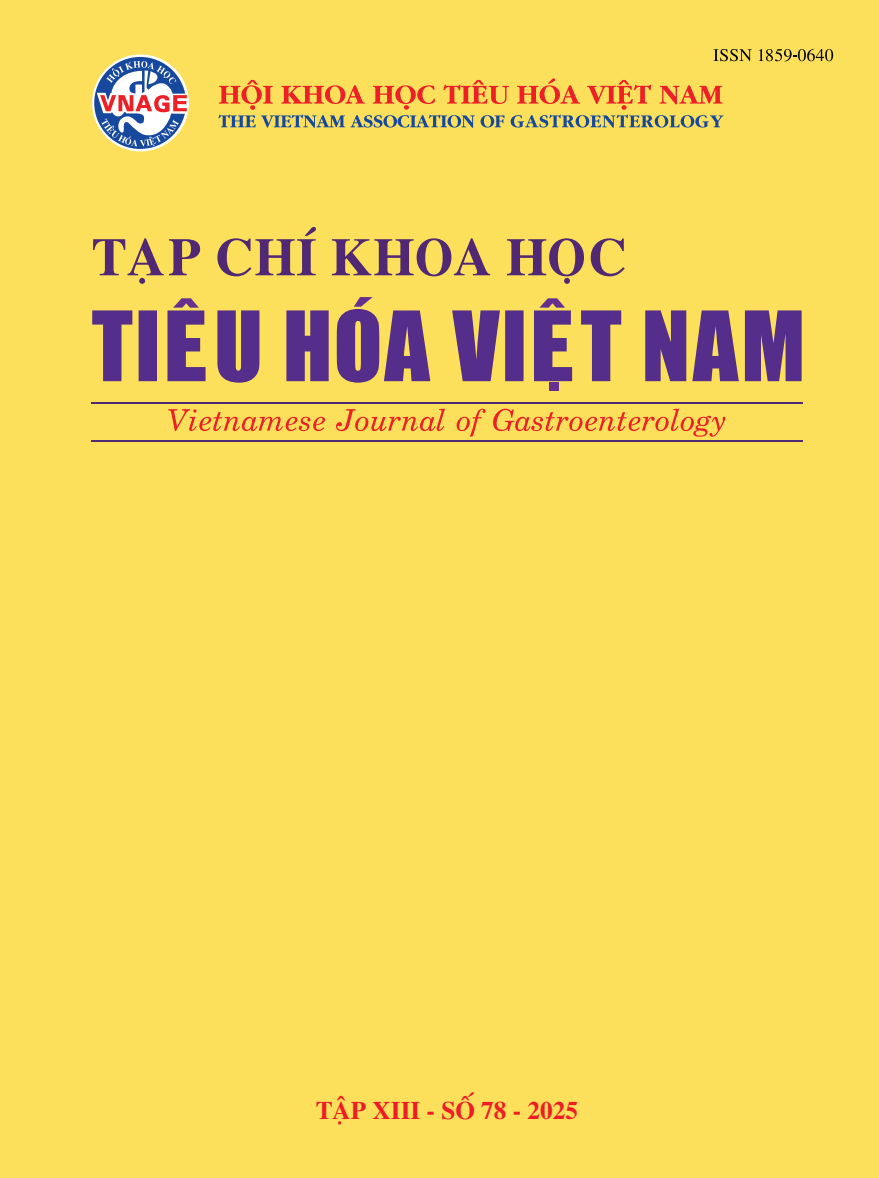Đặc điểm hệ vi khuẩn và kết quả điều trị viêm màng bụng nhiễm khuẩn tự phát ở bệnh nhân xơ gan
DOI:
https://doi.org/10.63583/4fzf2e26Từ khóa:
Xơ gan, viêm màng bụng, nhiễm khuẩn tự phátTóm tắt
Mục tiêu: Mô tả đặc điểm hệ vi khuẩn và đánh giá kết quả điều trị bệnh viêm màng bụng nhiễm khuẩn tự phát ở bệnh nhân xơ gan. Đối tượng và phương pháp: Nghiên cứu mô tả cắt ngang, có phân tích kết hợp theo dõi dọc, lấy mẫu thuận tiện trên 87 bệnh nhân xơ gan mất bù có biến chứng viêm phúc mạc nhiễm khuẩn tự phát điều trị nội trú từ tháng 1/2019 đến tháng 12/2024. Kết quả: Trong 87 bệnh nhân viêm màng bụng nhiễm khuẩn tự phát do xơ gan, tuổi 55,4 ± 10,2; 74,7% nam; BMI 20,1 ± 2,8; 88,5% Child‑Pugh B-C, E. coli (32,2%) và K. pneumoniae (24,1%) là tác nhân chủ yếu; tỷ lệ kháng cefotaxime và ciprofloxacin lần lượt 39,4% và 36,4%, trong khi kháng meropenem và vancomycin dưới 8%. Sau 7 ngày điều trị, 79,3% đáp ứng tốt, 20,7% thất bại; biến chứng hội chứng gan‑thận 14,9%, nhiễm trùng huyết 10,3%, tử vong 8,0%. Phân tích đa biến xác định Child‑Pugh C (OR = 3,76; p=0,022), creatinin > 1,5mg/dL (OR = 4,45; p=0,007) và vi khuẩn Gram âm kháng cephalosporin 3G (OR = 5,02; p = 0,005) là các yếu tố tiên lượng độc lập của thất bại điều trị hoặc tử vong nội viện. Kết luận: Tỷ lệ đáp ứng điều trị viêm màng bụng nhiễm khuẩn tự phát cao nhưng vẫn còn biến cố nặng, nhất là ở bệnh nhân Child‑Pugh C, suy thận và nhiễm vi khuẩn đa kháng.
Tài liệu tham khảo
1. Bello K.E., Irekeola A.A., Al-Mhanna S.B. et al (2023). Prevalence of Spontaneous Bacterial Peritonitis (SBP) in Hepatitis B (HBV), and Hepatitis C (HCV) Liver Cirrhosis: A Systematic Review and Meta-Analysis. Healthcare, 11(2), 275.
2. Sheikhbahaei S., Abdollahi A., Hafezi-Nejad N. et al (2014). Patterns of Antimicrobial Resistance in the Causative Organisms of Spontaneous Bacterial Peritonitis: A Single Centre, Six-Year Experience of 1981 Samples. International Journal of Hepatology, 2014(1), 917856.
3. Ding X., Yu Y., Chen M. et al (2019). Causative agents and outcome of spontaneous bacterial peritonitis in cirrhotic patients: community-acquired versus nosocomial infections. BMC Infectious Diseases, 19(1), 463.
4. Rostkowska K., Szymanek-Pasternak A., Simon K. (2018). Spontaneous bacterial peritonitis - therapeutic challenges in the era of increasing drug resistance of bacteria. Clin Exp HEPATOL, 4(4), 224-231.
5. Khan A.M.K., Haq M., Shah R. et al (2022). Comparative Analysis of Intravenous Ceftriaxone and Ciprofloxacin for the Treatment of Bacterial Peritonitis in Liver Cirrhosis. Pakistan Journal of Medical & Health Sciences, 16(08), 556-556.
6. Elzouki A, Hamad A, Almasri H, et al. (2021) Predictors of Short-Term Mortality Following First Episode of Spontaneous Bacterial Peritonitis in Hospitalized Cirrhotic Patients. Cureus 13(10): e18999. doi:10.7759/cureus.18999
7. Ajayi A.O., Adegun P.T., Ajayi E.A. et al (2013). Prevalence of spontaneous bacterial peritonitis in liver cirrhosis with ascites. The Pan African Medical Journal, 15(128).
8. Wong Y., Kalki R., Lin K. et al (2020). Short- and long-term predictors of spontaneous bacterial peritonitis in Singapore. smedj, 61(8), 419-425.
9. Fiore M., Maraolo A.E., Gentile I. et al (2017). Nosocomial spontaneous bacterial peritonitis antibiotic treatment in the era of multi-drug resistance pathogens: A systematic review. World Journal of Gastroenterology, 23(25), 4654-4660.
10. Iliaz R., Ozpolat T., Baran B. et al (2018). Predicting mortality in patients with spontaneous bacterial peritonitis using routine inflammatory and biochemical markers. European Journal of Gastroenterology & Hepatology, 30(7), 786.









